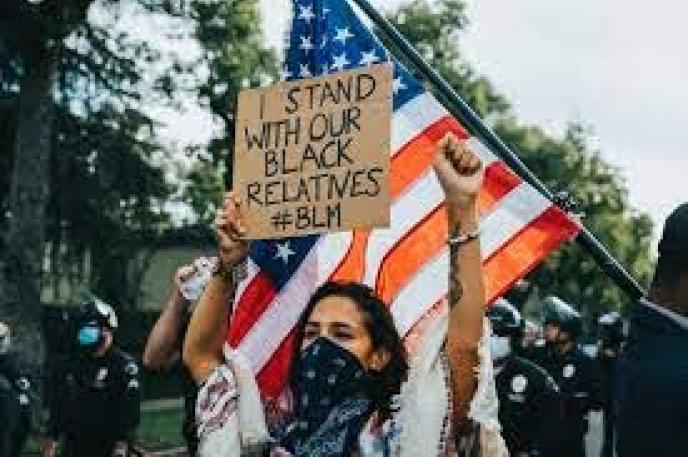
South Asians Can be Allies for Black Americans
November 9, 2020
I am a part of a multi-faceted, beautifully blended South Asian family. My parents are originally from Gujarat, India. They were married in Nairobi, Kenya after my mother lived there with her brother and other relatives for five years. Many people do not realize that the Indian diaspora is expansive in Southeast Africa – specifically Kenya, Uganda, Tanzania and South Africa. There are a variety of factors that bring people of Indian origin (PIOs) to the continent of Africa, including trade, travel, employment opportunities and curiosity. The British Empire also has a hand in bringing PIOs as indentured servants to Africa to build railroads and cotton gins.
Even with a slightly interconnected history, the relationship between the South Asian and Black American communities has been strained for years. The model minority myth is one culprit behind this division. I think it is important for South Asians to acknowledge and examine their privilege in the U.S. that comes with this divisive issue. The model minority myth touts the stereotype that Indians are hard-working, intelligent and passive people, in comparison to the general population, and has created a racial dichotomy between South Asians and Black Americans.
South Asians have capitalized on this privilege (as a result of the Civil Rights movement and the passing of the Immigration & Nationality Act of 1965) and many have done nothing to provide support or opportunity to Black people. What is so strange to me is that in our Indian culture, we are taught to keep our relationships close with everyone we meet. My mother and father raised me to call anyone older than me an Aunty or an Uncle. I was raised to call my friends and cousins “bhaiya” (meaning brother) and “behena” (meaning sister). So, why in a culture where we value strength in relationships, have we not employed that same courtesy to Black Americans?
The model minority myth inflated egos throughout the South Asian community and fostered an institutional racism and media bias fear of Black Americans. Unlike Black Americans, South Asians have not experienced centuries of injustices and our actions are not criminalized by the justice system.
So, how can South Asians become allies for the Black community? Educate yourself. Read books like Stamped from the Beginning by Ibram X Kendi, to better understand the history and ideology of racist ideas in America. Read The New Jim Crow by Michelle Alexander and learn about how Black men are disproportionately incarcerated in the US. Read So You Want to Talk About Race by Ijeoma Uluo to learn about microaggressions and how to frame conversations about race & racism. Read The Color of Law by Richard Rothstein to better understand institutional racism and how policies are put into place to oppress Black people. There are countless books to read and explore this topic, but don’t just stop there -- use literature to help combat the racist ideas typically exchanged within South Asian families. Use this knowledge to stand up and say something.
I know most South Asian families are raised to respect our elders and should never say anything to oppose the wisdom of our parents. But what if our parents never learned this information? Don’t be afraid to speak out and share facts & data about the countless injustices towards Black Americans – to help the older members of our community better understand what is really happening to Black people. Framing conversations is an effective strategy for communicating facts and data about racism. Framing conversations means explaining what system of oppression is in play that is negatively affecting the person or people involved. Sharing this data helps to drive a meaningful, productive narrative that exposes systems of disproportionality that are usually ignored or downplayed.
Even though conversations about race can be emotional and polarizing, there is a way to share information that encourages self-reflection and an increased understanding of perspectives we haven’t experienced personally. I will never fully know or understand what a Black person of color goes through, but I can learn from the lived experiences that are shared with me and help to catalyze change through the conversations I have with my friends, family, and circle of influence.
Here are some strategies when framing conversations:
- tie it directly to a system of disproportionality/oppression
- tie it to policies that prevent equal opportunity
- share and discuss the differences in racial AND socioeconomic disparities between South Asians and Black Americans.
The more you educate yourself about these oppressive systems of disproportionality, the more you will be able to advocate for the rights of Black Americans.
On your path towards becoming an ally, I urge you to examine your own implicit and explicit biases and ask yourself: how have I engaged in the stereotyping of Black people and what can I do to support this historically marginalized community? Your efforts may be new – but for the Black people of America, this is a continuation of a long, hard road towards equality, equity, social and racial justice – so let us stand up together and support our bhaiyas and behenas.
Be a part of the conversation with the Black Lives Matter program and Community Read 2021.
Resources:
https://www.tolerance.org/magazine/what-is-the-model-minority-myth
This blog was written by Amrita Patel in Outreach Services at Charlotte Mecklenburg Library.
